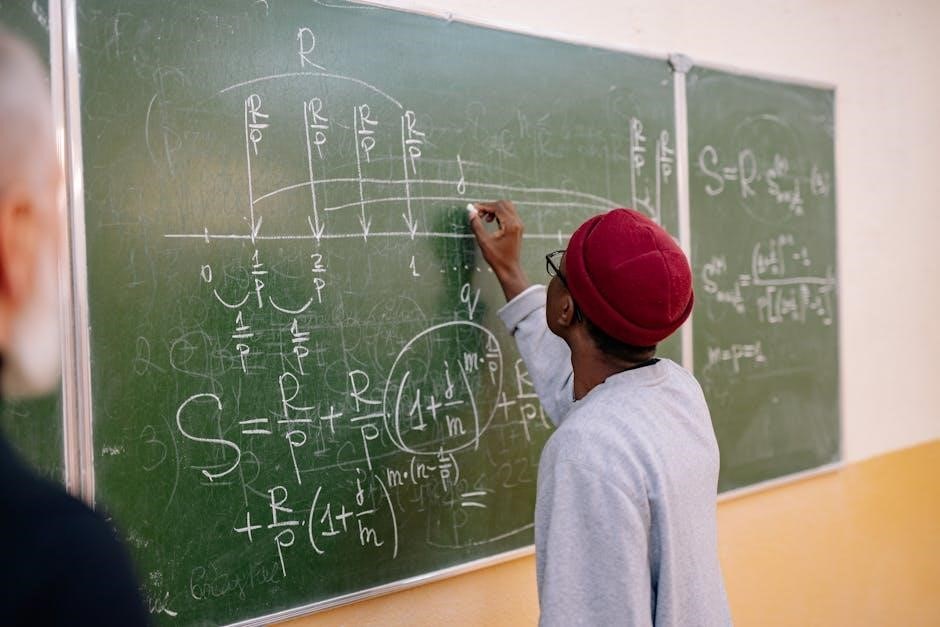
Linear equations are fundamental in mathematics, representing relationships between variables. They are expressed in the form of ax + by = c, where a, b, and c are constants.
These equations are essential for modeling real-world problems, such as budgeting, distance calculations, and scientific formulas, making them a cornerstone of algebraic studies.
1.1 Definition and Importance of Linear Equations
A linear equation is an algebraic expression of the first degree, where the highest power of the variable is one. It can be written in the form ax + by = c, where a, b, and c are constants, and x and y are variables. Linear equations are foundational in mathematics, representing direct relationships between variables.
They are crucial for solving real-world problems, such as budgeting, calculating distances, and modeling scientific phenomena. Understanding linear equations is essential for advancing in algebra and applying mathematical concepts to practical scenarios.
1.2 Key Concepts and Terminology
Key terms in linear equations include variables, coefficients, and constants. The slope-intercept form (y = mx + b) is vital, where m represents the slope and b is the y-intercept. Understanding independent and dependent variables is crucial, as they define the relationship within the equation. These concepts form the basis for solving, graphing, and interpreting linear equations in various mathematical and real-world contexts.

Understanding Linear Equations in Slope-Intercept Form
Linear equations in slope-intercept form (y = mx + b) represent lines on a graph. This form highlights the slope (m) and y-intercept (b), essential for analyzing relationships.
2.1 What is Slope-Intercept Form (y = mx + b)?
The slope-intercept form, y = mx + b, is a linear equation where m represents the slope, indicating the steepness of the line, and b is the y-intercept, the point where the line crosses the y-axis. This form is widely used for its simplicity in identifying key components of a line, making it easier to graph and analyze linear relationships. It is a fundamental concept in algebra and graphing.
2.2 Identifying Slope and Y-Intercept
In the slope-intercept form y = mx + b, m represents the slope, which measures the steepness of the line, while b is the y-intercept, indicating where the line crosses the y-axis. To identify these components, compare the equation to the standard form. For example, in y = 3x + 2, the slope (m) is 3, and the y-intercept (b) is 2. This allows for easy interpretation of the line’s behavior and position on a graph.

Solving Linear Equations
Solving linear equations involves isolating the variable using inverse operations. Start by simplifying the equation, then undo addition or multiplication to find the variable’s value.
3.1 Step-by-Step Process to Solve Linear Equations
To solve linear equations, start by simplifying both sides. Combine like terms and eliminate fractions or decimals if needed. Next, isolate the variable by performing inverse operations: undo addition by subtracting and undo multiplication by dividing. Finally, check your solution by substituting it back into the original equation to ensure both sides are equal; This method ensures accuracy and clarity in finding the variable’s value.
3.2 Clearing Fractions and Decimals in Equations
To clear fractions, multiply both sides of the equation by the least common denominator (LCD). For decimals, multiply by a power of 10 to eliminate the decimal points. This simplifies the equation by converting it into whole numbers, making it easier to solve. Always ensure the operation is applied to both sides to maintain equality and balance in the equation throughout the process.
Graphing Linear Equations
Graphing linear equations involves plotting points and drawing lines on a coordinate plane to visualize the relationship between variables. This method helps identify the slope and y-intercept, providing a clear representation of the equation’s behavior and solutions.
4.1 Plotting Points and Drawing Lines
Plotting points on a graph begins with identifying coordinates (x, y) from the equation. Each point is marked accurately on the grid. Once several points are plotted, a straight line connects them, ensuring the graph represents the equation’s slope and intercept. This method visualizes the relationship between variables, aiding in understanding and interpreting linear equations effectively.
4.2 Using Slope and Y-Intercept to Graph Lines
Graphing lines using slope and y-intercept involves starting at the y-intercept, where the line crosses the y-axis. The slope determines the line’s steepness and direction. A positive slope rises from left to right, while a negative slope falls. By plotting the intercept and moving according to the slope, the line is drawn accurately, providing a clear visual representation of the equation’s behavior and trends.

Systems of Linear Equations
Systems of linear equations involve two or more equations with the same variables. They can be solved using substitution or elimination, yielding one solution, no solution, or infinite solutions.
5;1 Solving Systems by Substitution and Elimination
Solving systems of linear equations involves two main methods: substitution and elimination; Substitution requires solving one equation for a variable and substituting it into the other equation. Elimination involves adding or subtracting equations to eliminate a variable. Both methods aim to find values of variables that satisfy all equations simultaneously. Carefully choosing the method based on the system’s complexity can simplify the problem-solving process.
5.2 Analyzing Solutions (One Solution, No Solution, Infinite Solutions)
A system of linear equations can have one solution, no solution, or infinite solutions. One solution occurs when the lines intersect at a single point. No solution happens if the lines are parallel and never intersect. Infinite solutions arise when the lines are identical, meaning all points satisfy both equations. Determining the type of solution is crucial for understanding the system’s behavior and interpreting real-world applications accurately.

Linear Inequalities
Linear inequalities involve expressions with inequality signs, such as <, >, ≤, or ≥. They represent ranges of values rather than a single solution.
Solving and graphing inequalities helps model real-world scenarios, like budget constraints or temperature limits, providing a visual understanding of the solution set.
6.1 Solving and Graphing Linear Inequalities
Linear inequalities are solved using algebraic manipulation, similar to equations. Multiply or divide by negative numbers reverses the inequality sign. Use number lines or coordinate planes to graph solutions, shading the appropriate region. For example, x > 3 is graphed with an open circle at 3 and shading to the right. Compound inequalities, like 2 < x < 5, are graphed by shading between the two values.
6.2 Writing and Solving Compound Inequalities
Compound inequalities combine two or more inequalities using “and” or “or.” For example, 2 < x < 5 represents values greater than 2 and less than 5. Solve by isolating the variable and interpreting the range. Use number lines or graphs to visualize solutions. Compound inequalities are useful in real-world scenarios, such as budgeting or temperature ranges, where multiple conditions apply.

Real-World Applications of Linear Equations
Linear equations model real-life scenarios, such as budgeting, distance calculations, and scientific formulas. They help solve problems like calculating costs, mixing solutions, and predicting weather patterns.
7.1 Modeling Real-Life Scenarios with Linear Equations
Linear equations effectively model various real-life situations. For instance, they can calculate the total cost of items, determine the time required for travel, or predict population growth. These equations are also used in budgeting, comparing rates, and understanding financial returns. By translating real-world problems into mathematical expressions, linear equations provide clear and actionable solutions, making them indispensable tools for decision-making and analysis in everyday life.
7.2 Interpreting Results in Context
Interpreting results of linear equations involves understanding their practical meaning. For example, in budgeting, if an equation shows $50 left after expenses, it indicates financial standing. Similarly, in travel scenarios, a solution might represent the time needed to reach a destination, ensuring plans are realistic. Always relate the mathematical solution back to the original context to ensure relevance and practicality.

Test-Taking Strategies
Effective time management and careful reading of questions are crucial. Always check your answers to ensure accuracy and completeness before submitting the test.
8.1 Tips for Answering Multiple-Choice Questions
Read each question carefully and identify key terms. Eliminate obviously incorrect options first, then select the best answer from the remaining choices.
Use the process of elimination to narrow down options. If unsure, avoid guessing blindly—consider skipping and returning after completing easier questions.
8.2 Managing Time Effectively During the Test
Allocate time evenly across all questions to avoid rushing. Skim through the test first to identify easier questions and tackle them early to build confidence and momentum.
Set a timer for each section and stick to it. Skip difficult questions initially, mark them for later, and use the elimination method to minimize time wasted on single problems;

Common Mistakes to Avoid
Common errors include incorrect sign handling, misapplying distributive properties, and forgetting to clear fractions. These mistakes often lead to incorrect solutions and wasted time during tests.
9.1 Pitfalls in Solving and Graphing Linear Equations
One common mistake is mishandling negative signs when distributing or combining like terms. Another pitfall is incorrectly identifying slope and y-intercept from the equation. Additionally, students often plot points inaccurately, leading to incorrect graph shapes. Forgetting to simplify equations before graphing can also result in errors. It’s crucial to double-check each step to avoid these pitfalls and ensure accurate solutions and visual representations.
9.2 Avoiding Errors in Systems of Equations
When solving systems of equations, common errors include incorrect substitution or elimination steps. Students often miscalculate during algebraic manipulations or fail to verify solutions in both original equations. Misaligning coefficients or constants can lead to incorrect solutions. It’s essential to work methodically, check each step, and ensure that solutions satisfy all equations in the system to maintain accuracy and avoid misleading results.

Final Review and Practice
Regularly review linear equations concepts and practice with diverse problems. Utilize recommended resources, such as worksheets or online tools, to reinforce understanding and prepare for assessments effectively.
10.1 Recommended Resources for Additional Practice
To deepen understanding and mastery, utilize resources like Khan Academy, IXL, and online worksheets. These platforms offer interactive exercises, video tutorials, and practice tests tailored to linear equations.
- Khan Academy: Provides step-by-step explanations and exercises.
- IXL: Offers personalized practice with real-time feedback.
- Online Worksheets: Printable or digital sheets for hands-on practice.
These tools help reinforce concepts and prepare for assessments effectively.
10.2 Self-Assessment Strategies
Regular self-assessment is crucial for mastering linear equations. Set clear goals, track progress, and identify weak areas. Use practice tests to evaluate understanding and review mistakes. Reflect on problem-solving approaches and adjust study habits accordingly. Consistent self-evaluation ensures readiness for assessments and builds confidence in mathematical skills.
- Set specific, measurable goals for each study session.
- Review errors to understand common pitfalls.
- Use resources like practice tests to gauge progress.